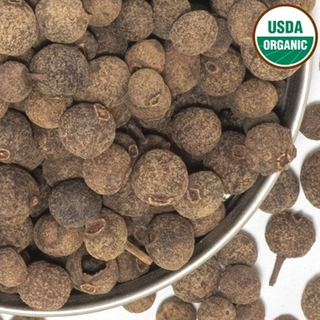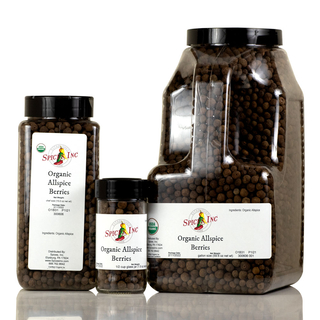Organic Allspice Berries




Organic Allspice Berries
Organic Allspice Berries, Pimenta dioica, are also referred to as organic pimento berries, whole allspice berries or organic dried allspice berries. This spice comes from the family Myrtaceae, or myrtle, and is closely related to clove, eucalyptus, guava and the bay rum tree.
Allspice’s name and multi-faceted flavor means it is often mistakenly thought of as a blend, but it is in fact one spice that comes from one berry. It is the only spice that is grown exclusively in the Western Hemisphere and is native to the Caribbean, Mexico, Central America, and South America.
Businesses that frequently purchase Organic Allspice Berries are:
- American and Indian restaurants;
- bagel and breakfast shops;
- catering companies;
- brewers; and
- companies that manufacture biltong or jerky
We also have Organic Ground Allspice, Allspice Berries, Ground Allspice, Jamaican Allspice Berries, and Ground Jamaican Allspice available.
Flavor Profile
Organic Allspice Berries are peppery and astringent, with notes of cinnamon, citrus, and clove.
How To Use
Organic Allspice Berries have a wide range of uses, and can be found with meats like chicken, pork, lamb, beef, and seafood. Add to chicken, tomato, and vegetable soup, or to chilis, gravies, and marinades. Or steep in rum to make a homemade Allspice dram for cocktails.
Allspice is often used in pickling or in relish dishes. It is delicious on carrots, parsnips, sweet potatoes, turnips and winter squash, and is also at home in sweet treats like apple pie, fruit compote, pumpkin pie, chili sauces, plum pudding, rice pudding, cookies, gingerbread, spice cakes, or sweet rolls.
Allspice works well in combination with chili powder, cloves, coriander, garlic, ginger, mustard, pepper, rosemary and thyme.
| Also Called | Organic pimento berries, whole allspice berries, or organic dried allspice berries |
| Species | Pimenta dioica |
| Ingredients | Whole organic allspice berries |
| Flavor Profile | Peppery, astringent, notes of cinnamon, citrus, and clove |
| Recommended Uses | Soups, stews, meats, vegetables, sweet treats, marinades, cocktails |
| Cuisine | Global |
| How To Store | Airtight container in a cool, dark place |
| Shelf Life | 1-2 years |
| Country of Origin | Guatemala, Honduras |
Nutrition Facts
Serving Size1 tsp
Amount Per Serving
Calories5
% Daily Value*
Total Fat0g0%
Saturated Fat0g0%
Trans Fat0g
Polyunsaturated Fat0g
Monounsaturated Fat0g
Cholesterol0mg0%
Sodium1.4mg0%
Total Carbohydrate1.3g0%
Dietary Fiber0.4g2%
Total Sugars0.0g
Added Sugars0g0%
Sugar Alcohol0.0g
Protein0.1g0%
Vitamin D0mcg0%
Calcium12mg1%
Iron0mg1%
Potassium20mg0%
*The % Daily Value (DV) tells you how much a nutrient in a serving of food contributes to a daily diet. 2,000 calories a day is used for general nutrition advice. These values were calculated and therefore are approximate. For more accuracy, testing is advised.
